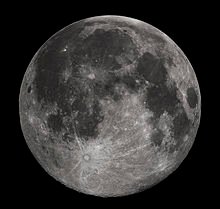The Far Side or The Dark side...

For some of you the title might sound dumb, especially if you're well versed in the mechanics of our solar system. But thanks to some productions of our pop-culture (which I am not going to name) many of us could've gotten this a little bit wrong.
I recently got into a little discussion with a friend about the Moon. I mentioned the theoretical possibility of military presence on the "dark side of the moon". He laughed at it, explaining the moon doesn't have a dark side, because it spins just like earth do and we can see all of the moon. Turns out we were both half wrong.
Yet somehow partially correct.
The moon spins around the Earth and it does spin around it's own axis, HOWEVER, the time it takes the Moon to make a turn around the is Earth nearly equal to the time it takes it to spin around itself. And so, as it slowly circles around the Earth, it also turns as much around itself, and this causes the Moon to keep the same hemisphere always facing the Earth. Analogically there's a side which always faces away from the Earth.
It's never seen from Earth, but every two weeks, for two weeks it's exposed to the Sun and it's called The Far Side of The Moon.

Due to tidal locking, the inhabitants of the central body (Earth) will never be able to see the satellite's (Moon) green area.
Far Side of the Moon
The far side has been photographed and seen by astronauts orbiting the moon as part of the Apollo mission and by dedicated satellites launched to the Moon since.
This is the acclaimed best picture we've got so far Dwingeloo Telescoop on Twitter
Interestingly, if you see that photography, the far side, which is facing away from the Earth seems to be much less damaged than the near side. Is in't it strange that there seem to be way larger craters facing the earth than the space?
What's your best theory for why these huge craters are on near side but not on the far side?
Direct comparison (first image is the far side, the second is the near side)


As if this wasn't enough¹, the biggest crater on the Moon (South Pole–Aitken basin), and one of the largest known impact craters in our Solar System, is directly on the bottom (South Pole) of our natural satellite. It's really huge - 2500km wide and 13km deep. It would fit most of the United States.
Topographic map and a photo of the crater:


The black ring on the topographic map is an old image artifact, and doesn't represent anything specific
¹MOON IS TOO MYSTERIOUUUU

Edit this post was inspired partially by a friend of a friend, who at the age of 17 believed what we perceive as the Moon is the back of the Sun. Made me feel less dumb for thinking there is a permanently dark side of the Moon.
Congratulations @wildcrafts! You have completed the following achievement on the Steem blockchain and have been rewarded with new badge(s) :
You can view your badges on your Steem Board and compare to others on the Steem Ranking
If you no longer want to receive notifications, reply to this comment with the word
STOPVote for @Steemitboard as a witness to get one more award and increased upvotes!
Downvoting a post can decrease pending rewards and make it less visible. Common reasons:
Submit